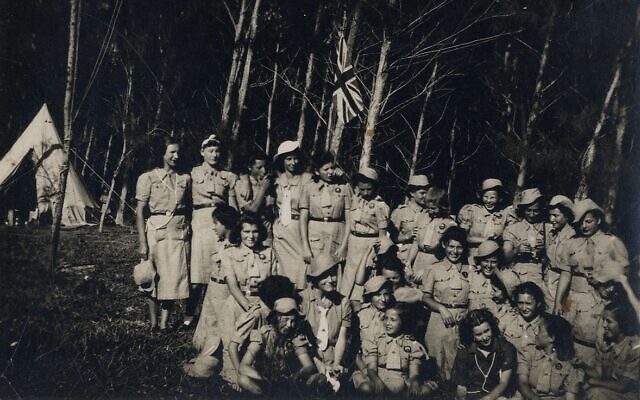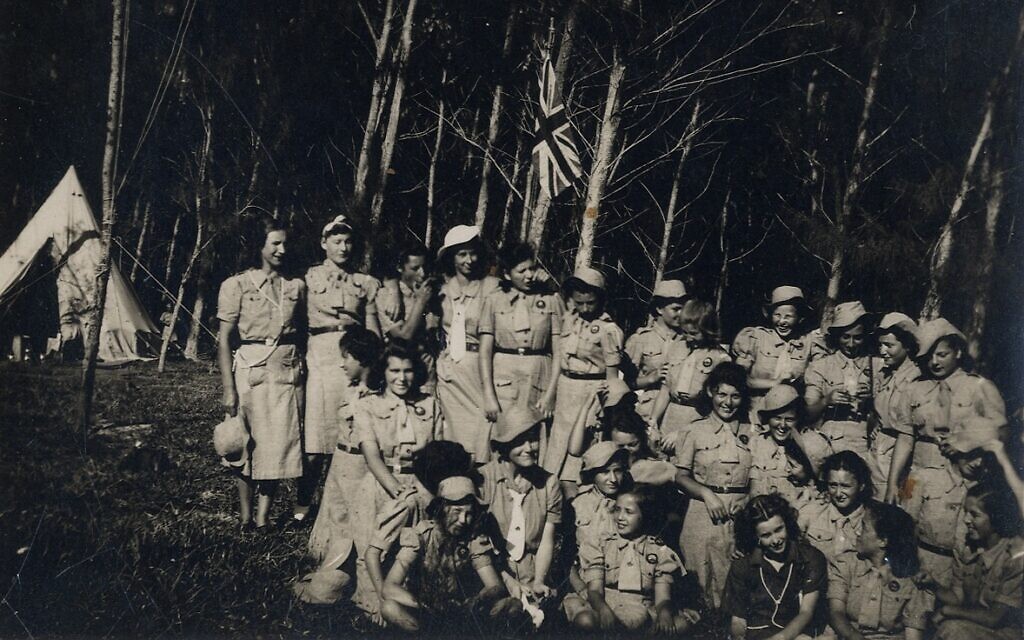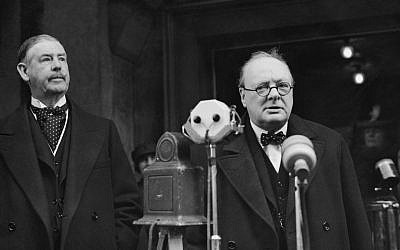They fled the Nazis to Mandate Palestine in 1940, only to be deported and, over Churchill’s objections, locked up for 5 years; August 12 marks 75 years since their release
By ROBERT PHILPOT, TOI 12 August 2020,
LONDON — On December 5, 1940, 1,580 Jewish men, women and children were taken from the Atlit detention center near Haifa, transferred on to two ships, and deported to the island of Mauritius in the Indian Ocean.
On their arrival in the small British colony 17 days later, the refugees — who had fled Nazi-occupied Europe three months prior — were taken to the Beau Bassin central prison where they were held behind bars for nearly five years.
The deportation was the first and only occasion during the war on which Jewish refugees who had reached the coastline of Palestine were forcibly removed from the country. The decision of the British Mandate authorities reflected both a determination to deter illegal immigration to Palestine and a fear that Nazi spies might lurk among the ranks of the refugees. At the same, however, the Haganah — the paramilitary organization representing the Jews in Mandatory Palestine — was equally resolved to prevent the deportation — a desire which was to have tragic and bloody consequences.
As the 75th anniversary of their release is marked in a virtual commemoration event on August 12, the refugees’ largely forgotten story is being pieced together by Israeli academic Dr. Roni Mikel-Arieli from both colonial records and the memoirs, letters and oral histories of the detainees, as well as the testimonies of local Mauritians.
“It’s very much a marginalized story in Israel,” Mikel-Arieli told The Times of Israel from Washington, DC, where she has been conducting her research on the refugees. “Not a lot of people know about it. When I talked to friends, my mother and father, and grandmother, they had never heard about it. I was born and raised in Israel, I’ve always been very much interested in the history of my country, and I am a Holocaust researcher, but I didn’t hear about this until I went to South Africa for my PhD research in 2014.”
The refugees who were deported to Mauritius were part of a larger group of 3,500 Jews who left Bratislava, the capital of the pro-Nazi Slovak Republic, on September 5, 1940, aboard two ships: the Uranus and Helios. A week later, the refugees arrived at Tulcea, Romania, where they were transferred onto three ships: the Pacific, Milos and Atlantic. The group — which included Jews from Vienna, Prague, Brno, Berlin, Munich and Danzig — was highly diverse. Most of the Viennese men had been rounded-up and sent to Dachau after Kristallnacht; their release had been conditional on their leaving Europe immediately.
But escape from the Nazis came at a high price.
“It was a physically and mentally hard journey,” says Mikel-Arieli. “It was very traumatic.” Although conditions were poor on all three ships, those aboard the Atlantic were particularly dire. The boat trailed behind the Milos and Pacific by two weeks; when it ran out of coal, parts of the actual ship were burned in order to fuel its journey. Some passengers died aboard the boat and their bodies thrown overboard.
‘A great deal of trouble’
Nor did arrival in Palestine bring relief. The refugees had sung Hatikva, Israel’s future national anthem, as they finally caught sight of Mount Carmel, but their reception was a cold one.
“They were received not only by the British authorities but by the Jewish Yishuv authorities with indifference and cynicism. This comes across very strongly in the refugees’ testimony,” says Mikel-Arieli.
The British had, in fact, been planning for the refugees’ arrival almost from the moment they set sail from Bratislava. In October 1940, the Colonial Secretary, George Lloyd, requested the governor of Mauritius to accommodate 4,000 Jewish refugees he believed were heading for Palestine. In some respects, Lloyd’s attitude was unsurprising: just a year before, the British government’s White Paper had set strict limits on the number of Jewish migrants who would be allowed into Palestine.
But enforcement of the quota wasn’t his only concern. The refugees, Lloyd warned the Mauritius governor, should be held in a camp, behind barbed wire and kept under constant guard.
“The problem of illegal immigration into Palestine which has caused a good deal of trouble in the past, has once more become acute […] All these immigrants now come from enemy or enemy occupied countries. We have no check whatever over them,” the Colonial Office suggested in a confidential telegram in November 1940 which Mikel-Arieli has uncovered.
The telegram, she believes, provides “a window into the British Mandate authorities’ perception of the Jewish refugees not merely as illegal immigrants but as a possible threat.”
The commander of British military forces in the Middle East similarly warned that it was unlikely that the Nazis would not attempt to plant agents among the refugees. Such fears were not confined to Palestine: in June 1940, as the danger of a German invasion loomed large, the British government had ordered the temporary internment of all “enemy aliens” in the UK, including German and Austrian Jewish refugees (although the process of releasing those, including Jews, who were not considered a danger was underway by this point).
The role of the Nazis in the refugees’ story is still shrouded in mystery. The three ships were chartered in September 1940 by the Central Office for Jewish Emigration under its head, Berthold Storfer. Storfer, an Austrian Jewish financier, is a controversial figure who worked closely with Adolf Eichmann and has been accused of walking “a thin line between assistance and collaboration.” (He was later murdered at Auschwitz).
“We know that the Nazis were involved, and we know that if they weren’t, the departure of the Jews wouldn’t have been possible at that point,” argues Mikel-Arieli.
The attitude of the British authorities towards the refugees affected that of the Yishuv, or Jewish establishment in Mandatory Palestine. It did not want to break British law by encouraging illegal immigration nor to be considered as in any way collaborating with the Nazis. “For the Yishuv, it was a headache,” Mikel-Arieli believes.
Churchill’s reservations
Winston Churchill speaking in January 1939. (photo credit: AP Photo/ Staff/ Putnam)<
The British government was, however, not entirely at one in its approach and there was an undercurrent of disquiet. The prime minister, Winston Churchill, attempted to soften Lloyd’s orders that the refugees be held behind barbed wire, warning him: “We cannot have a British Dachau.”
But Churchill’s request — that the Jews be treated as refugees and not criminals — was effectively ignored.
The Cabinet also raised concerns when Lloyd raised the prospect of deporting the refugees to the British colony of Trinidad in the Caribbean. Mauritius, unlike Trinidad, was not on America’s doorstep and was considered a rather more discreet location to lock up refugees.

A group of detained girls in a youth movement activity in a grove in Mauritius. (Courtesy Ghetto Fighters’ House Archives, Israel)
But, as the British planned the deportation, the Haganah readied to stop them. Refugees from the Milos and Pacific had already been transferred to another ship, the Patria, which, it was planned, would deport all 3,500 Jews to Mauritius.
As the Atlantic neared Haifa, the Haganah decided to attempt to scuttle the Patria by setting off explosives on board. Although it had attempted to pass word to the refugees already aboard the Patria that they should jump from the ship at a designated time, the attempted sabotage went horribly wrong. Some 260 refugees, and a number of British officers, died in the explosion.
“I think the perception was that we have to stop the deportation at any cost,” says Mikel-Arieli.
The explosion on board the Patria did have an impact, however. In compliance with international law, the British decided to allow those refugees who had survived the blast — some 1,700 in total — to remain in Palestine.
The Atlantic passengers were not so lucky, however. While they were initially taken with their fellow refugees to Atlit, 10 days later, on December 5, the British carried out their threat to deport them. They had been warned the previous evening to be packed and ready to leave the following morning.
The refugees decided not to go without a fight: They refused to pack and many did not dress, believing that the British soldiers would be embarrassed by naked women refusing to leave the detention center. The authorities were not deterred, though, and the refugees, many of them still undressed, were taken to the ships which waited to deport them to Mauritius.
“It was a very violent deportation and a lot of the refugees resisted,” says Mikel-Arieli.
Harsh conditions
In Mauritius itself, the ground had been prepared. Detainees at the Central Prison of Beau Bassin were removed to free up space for the refugees. When they arrived, the men were separated from the women and children, who were taken to a newly installed camp adjoining the prison. Meanwhile, new regulations were passed to prevent the refugees from challenging their detention in the local courts and barring local people from directly contacting them.
The first 18 months of the refugees’ time in Mauritius were particularly harsh. They could not leave the camp and there was little by way of family life. Indeed, their detention, combined with the authorities’ insistence the refugees would never be allowed to enter Palestine, proved devastating for some. Although unrecorded on any official documents, a number of refugees died by suicide.
In total, 128 refugees did not survive their time on Mauritius, and are buried at the St. Martin Jewish cemetery on the island. One particularly tragic case concerned an artist, Fritz Haendel, who hanged himself in his cell; his body was discovered by his wife when she came to tell him that she had just been told by the camp’s doctor that she was pregnant.
At the outset of the detention, the British divided the refugees into groups according to their nationality and asked them to elect a representative. Over time, a degree of trust between the detainees and the commanders of the camp and local authorities was built. This reflected both the refugees’ cooperative attitude and the authorities’ realization that there were no enemy agents in the detainees’ ranks.
Thus in 1942, conditions were significantly relaxed with some of the detainees permitted to work outside the camp and separated husbands and wives able to meet for a couple of hours each week. The refugees developed a rich cultural, political and social life. They established workshops, a Zionist association, schools and two synagogues.
During the last year of their detention, the authorities permitted groups of refugees to leave the prison and vacation at a summer camp on the island.
The refugees were, moreover, not without friends and supporters. South Africa’s Jewish community established a special committee, sent supplies, including religious items and books, and bought products made by the refugees in their workshops. An attempt by the South African Jewish Board of Deputies to send a delegation in January 1941 to visit the prison was rebuffed by the British authorities. Attempts to negotiate the refugees’ release were similarly unsuccessful. The detainees, the British insisted, were illegal immigrants interned for committing a crime.
The refugees also later testified to the help they received from the local Mauritian population. Made aware of their imminent arrival, local people rented boats, waved at the dockside and lined the roads to welcome the refugees. They also collected donations and clothes for the detainees. When conditions were relaxed and refugee artists staged an exhibition of their works, local people purchased some of their artwork.
The refugees’ arrival was “a very unusual event for this small island,” says Mikel-Arieli, adding that they were “received with open arms.”
Back in Palestine, however, Jewish institutions ignored telegrams from the detainees asking them to intervene on their behalf. When Moshe Sharett (then Shertok), the head of the political department at the Jewish Agency, was questioned by the refugees’ families at public meetings, his response was that while the detainees were imprisoned, they were at least safe.
“Of course, the refugees in Mauritius were safer than those still in Europe,” says Mikel-Arieli. “That’s a fact and something that the detainees themselves [acknowledged] … Mauritius was not Dachau and it was not Auschwitz. It was something else.” Nonetheless, she continues, it ignores the fact that the refugees were detained for nearly five years.
As the war drew to a close, on February 21, 1945, the governor of Mauritius informed the detainees’ leadership that the British authorities had decided to allow the refugees to enter Palestine. Six months later, the refugees left the island. Most took up the offer to go to Palestine, although some went to the US and Canada or returned to Europe.
Telling their story
Over the past two decades, the refugees’ story has, at last, begun to be told. Mauritian writer Geneviéve Pitot’s book, “The Mauritian Shekel,” was published in 1998; the South African film maker, Kevin Harris, produced a documentary in 2007; and the following year an archival collection of photographs, documents, letters and memoirs was deposited with the Ghetto Fighters’ House in Israel. In 2014 the Beau Bassin Jewish Detainees Memorial and Information Center opened its doors.
Mikel-Arieli, who visited Mauritius last year, found considerable interest in a project she has established with the Johannesburg Holocaust & Genocide Center, the Rosa Luxemburg Stiftung Southern Africa, the Beau Bassin Jewish Detainees Memorial and Information Centre, and the DIS-MOI organization in Mauritius to collect material and testimony from local people about the refugees’ time on the island.
Mikel-Arieli believes one of the most important aspects of her research is the process by which the refugees came to be marginalized by the British, the Yishuv and the colonial authorities in Mauritius.
“This marginalization process began when they left Bratislava,” Mikel-Arieli says. “It is replicated in the way we remember — or don’t remember — this episode. The way the refugees were marginalized — this ‘otherness’ — created a legitimacy to keep them interned in a prison for five years under strict conditions — and for this history to be forgotten until now.”





Leave a Reply
You must be logged in to post a comment.